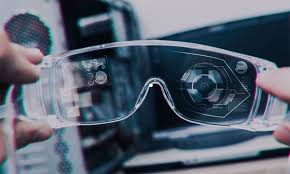
Future Trends in Augmented and Virtual Reality
Future trends in AR and VR point toward more immersive, accessible, and intelligent experiences across work, education, healthcare, retail, tourism, and entertainment. Enhanced hardware, AI integration, and ultra-fast connectivity will make these technologies a daily tool rather than a novelty. While costs, comfort, and infrastructure remain challenges, their potential to blend digital and physical worlds promises to revolutionize how we learn, shop, heal, and connect in the coming decade.
✨ Raghav Jain

Introduction
Technology is no longer just about screens—it’s about stepping inside the digital world itself. Augmented Reality (AR) and Virtual Reality (VR) are changing how we work, play, shop, learn, and connect. AR adds a digital layer to the real world, while VR takes you into a fully immersive digital environment.
What was once seen only in sci-fi movies is now a booming industry with applications in education, healthcare, retail, travel, and entertainment. As AR and VR technologies evolve, their future trends promise more realism, accessibility, and integration into our everyday lives.
In this article, we’ll explore the future trends shaping AR and VR, the technology behind them, their potential challenges, and practical ways individuals and businesses can prepare for this digital shift. Augmented Reality (AR) and Virtual Reality (VR) have rapidly transformed from niche technologies into mainstream tools that are shaping the way we interact with the world, consume content, and conduct business. The future of AR and VR promises even deeper integration into everyday life, driven by advancements in hardware, software, and creative applications. One of the most significant trends is the ongoing miniaturization and improvement of hardware. AR glasses and VR headsets are becoming lighter, more comfortable, and more powerful, allowing users to engage with immersive experiences for longer periods without discomfort. Companies are investing heavily in developing devices that are not only high-performing but also aesthetically appealing, which will accelerate adoption among casual consumers as well as professionals. This trend indicates a shift from bulky and expensive setups to portable, affordable devices that could soon be as commonplace as smartphones.
Another critical trend is the enhancement of spatial computing and mixed reality experiences. AR is no longer limited to overlaying digital objects onto the physical world; future AR systems will understand and interact with the real environment in a far more sophisticated way. For instance, AR applications could analyze a user’s surroundings in real time, providing dynamic contextual information, navigation guidance, or even interactive gaming experiences that blend seamlessly with the real world. Similarly, VR experiences are evolving beyond static environments. Advanced VR platforms will support real-time interactions with AI-driven characters, adaptive storylines, and hyper-realistic simulations, making virtual worlds increasingly indistinguishable from reality. This progression will significantly impact entertainment, education, and professional training by providing deeply immersive and personalized experiences.
Artificial Intelligence (AI) and machine learning are also playing a pivotal role in shaping the future of AR and VR. By integrating AI, these technologies can deliver smarter, more intuitive, and personalized experiences. For example, AI can power virtual assistants within AR applications to provide contextual advice, automate repetitive tasks, or simulate realistic social interactions in virtual spaces. In VR, AI can create adaptive learning environments, dynamic game narratives, or realistic avatars that respond convincingly to user actions. As these AI-driven capabilities mature, AR and VR systems will become more responsive, predictive, and capable of understanding human behavior, creating a far more engaging and seamless interaction between humans and digital environments.
The convergence of AR, VR, and the metaverse is another trend that is gaining significant traction. The metaverse, a collective virtual space where users can interact, work, and play, relies heavily on AR and VR technologies to provide immersive and persistent experiences. In the near future, these virtual worlds will not only serve as entertainment platforms but also as spaces for commerce, education, and professional collaboration. Businesses are increasingly exploring virtual showrooms, remote training environments, and virtual offices, while social platforms are experimenting with interactive 3D spaces for communication. This integration will blur the lines between the physical and digital worlds, fundamentally altering how people socialize, learn, and work.
Healthcare and medicine are expected to benefit enormously from future AR and VR trends. VR is being utilized for pain management, mental health therapy, and surgical training, while AR is enhancing precision in surgical procedures and medical diagnostics. The combination of high-fidelity simulations, real-time data visualization, and AI-driven analysis can improve patient outcomes, reduce risks, and provide more effective training for medical professionals. As these applications become more sophisticated, the adoption of AR and VR in healthcare will likely expand beyond specialized institutions, potentially becoming a standard tool in clinics, hospitals, and even home healthcare settings.
Education is another sector poised for transformation through AR and VR. Immersive learning experiences enable students to explore historical events, scientific phenomena, or complex concepts in ways that traditional methods cannot. For instance, VR can transport students to ancient civilizations or distant planets, while AR can overlay interactive diagrams and real-time data in classrooms. These technologies cater to diverse learning styles, increase engagement, and improve retention. As AR and VR content creation becomes more accessible, educational institutions will likely integrate immersive technologies into standard curricula, creating a more interactive and personalized learning environment.
The gaming and entertainment industries will continue to drive innovation and adoption in AR and VR. Games are becoming increasingly immersive, incorporating haptic feedback, motion tracking, and realistic environments to enhance user experiences. Additionally, AR is enabling interactive storytelling and live events, such as concerts and sports experiences, that merge digital elements with real-world settings. This blend of entertainment and immersion will extend beyond gaming into other forms of media, including movies, virtual tourism, and interactive art, providing users with experiences that are both engaging and participatory.
Commerce and retail will also be shaped by AR and VR technologies. Virtual try-ons, interactive product demos, and immersive shopping experiences allow consumers to explore products before making purchasing decisions, reducing friction and enhancing satisfaction. Businesses are leveraging these technologies to provide personalized marketing experiences and to create digital twins of physical stores for global access. As these systems become more seamless, AR and VR could redefine the entire customer journey, offering convenience and interactivity that traditional methods cannot match.
Finally, the development of 5G and beyond will play a critical role in the expansion of AR and VR. High-speed, low-latency connectivity enables seamless streaming of high-resolution content, real-time interactions, and cloud-based AR/VR applications without the need for heavy local processing. This technological backbone will empower mobile and wearable devices, allowing users to access immersive experiences anytime, anywhere. Combined with cloud computing and edge technologies, future AR and VR applications will be faster, more scalable, and more accessible, further accelerating mainstream adoption.
In conclusion, the future of Augmented and Virtual Reality is poised for extraordinary growth and integration into everyday life. From lightweight hardware and spatial computing to AI-driven personalization and metaverse integration, these technologies will revolutionize industries ranging from healthcare and education to entertainment and commerce. As AR and VR continue to evolve, they will blur the lines between the digital and physical worlds, offering immersive, interactive, and personalized experiences that enhance how people learn, work, play, and connect. The next decade promises a dynamic landscape in which AR and VR are not just tools but essential platforms for innovation, communication, and creativity.
Understanding AR and VR
Before diving into the future, let’s quickly understand the difference:
- Augmented Reality (AR): Enhances the real world with digital overlays like 3D models, navigation markers, or interactive objects. Example: Using your phone to see how a sofa fits in your living room.
- Virtual Reality (VR): Immerses you in a computer-generated 3D world, often using headsets. Example: Exploring a virtual art gallery or training for surgery in a simulated environment.
Both are powered by technologies like computer vision, AI, 3D rendering, motion tracking, and cloud computing.
Future Trends in AR and VR
1. Hyper-Realistic Graphics and Environments
Future AR and VR systems will deliver near-photorealistic experiences with improved rendering, lighting, and textures. You’ll feel like you’re standing inside a real place, whether it’s a virtual museum or a simulated Mars expedition.
2. AR Glasses for Everyday Use
Bulky headsets will give way to sleek AR glasses that look like regular eyewear but display navigation, translation, and notifications right in your field of vision. Imagine walking down a street with restaurant reviews floating over each café.
3. AI-Powered Personalization
AI will analyze your behavior and preferences to create custom VR environments or AR overlays. This means learning modules, workouts, or even shopping experiences will adapt in real-time to your needs.
4. Immersive Remote Collaboration
Virtual offices and meeting rooms will become more common, allowing coworkers from different continents to brainstorm around the same virtual whiteboard as if they were together.
5. Integration with 5G and Beyond
The rise of ultra-fast networks will remove lag, allowing real-time AR navigation and VR gaming without motion sickness or slow loading.
6. Healthcare and Therapy Applications
VR will help train surgeons with realistic simulations, while AR will guide complex surgeries in real time. VR-based therapy will also expand for treating PTSD, anxiety, and phobias.
7. AR in Retail and E-Commerce
You’ll be able to “try on” clothes virtually, test makeup shades on your face, or see how a piece of furniture fits your room—all before buying.
8. Full Sensory Experiences
Beyond sight and sound, future VR systems will integrate touch (haptics), smell, and even taste simulations to make experiences more lifelike.
9. Education and Skill Training
Students will explore the Great Wall of China in VR or see an AR model of the solar system in their classroom. Industries will train workers through realistic simulations.
10. Mixed Reality (MR) Integration
The line between AR and VR will blur, creating experiences that switch between real and virtual worlds seamlessly.
Benefits of AR and VR Advancements
- Enhanced Learning and Training – Complex concepts become easier to grasp through interactive simulations.
- Better Decision Making – Try before you buy in retail, real estate, or travel.
- Improved Healthcare Outcomes – Safer surgeries and better therapy options.
- Cost Savings – Virtual training eliminates travel and physical setup costs.
- Global Connectivity – Breaks down physical barriers for work, socialization, and education.
Challenges That Need Addressing
- High Development Costs: Creating quality AR/VR content requires investment.
- Hardware Limitations: Devices still need to become lighter, cheaper, and more comfortable.
- Privacy Concerns: Data collected by AR glasses or VR apps must be secured.
- Motion Sickness Issues: Still a problem for some users during extended VR sessions.
- Digital Divide: Access remains limited in rural or underdeveloped areas.
Daily Practices to Stay Future-Ready
Morning
- Spend 10 minutes exploring an AR learning app (like anatomy, language, or history tools).
- Read tech updates about AR/VR advancements.
Midday
- If in a tech-related job, experiment with free AR/VR development tools.
- Try VR fitness apps for a short workout session.
Evening
- Join a virtual social space or hobby community in VR.
- Watch immersive 360° videos to stay familiar with the technology.
Weekly AR/VR Engagement Ideas
- Attend one VR-based event (concert, museum tour, or conference).
- Try a new AR app for shopping, navigation, or learning.
- Connect with AR/VR communities online to discuss trends.
- Test emerging devices at tech stores or exhibitions.
- Explore VR meditation or relaxation environments to unwind.
How Businesses Can Prepare for the Future of AR and VR
- Experiment with Prototypes – Start with small AR/VR projects for training, marketing, or product demos.
- Invest in Employee Training – Upskill teams in AR/VR tools and software.
- Collaborate with Developers – Partner with AR/VR creators to bring innovative ideas to life.
- Focus on Accessibility – Design experiences that work on multiple devices, not just high-end headsets.
- Prioritize Privacy and Ethics – Be transparent about data usage and user safety.
Myths About AR and VR: Busted!
“VR is only for gamers.”
→ Not true! It’s used in healthcare, education, real estate, retail, and more.
“AR glasses will replace smartphones overnight.”
→ Unlikely. The transition will be gradual as people adapt.
“Only tech experts can use AR/VR.”
→ False. Many platforms are beginner-friendly with simple interfaces.
“VR is too expensive for small businesses.”
→ Costs are dropping, and many affordable entry-level solutions exist.
“AR and VR will make real-life interactions obsolete.”
→ Not at all. They’re tools to enhance—not replace—human connection.
Practical AR and VR Apps You Can Try Today
- For Learning: Google Expeditions, JigSpace
- For Shopping: IKEA Place, Sephora Virtual Artist
- For Fitness: Supernatural VR, FitXR
- For Relaxation: Nature Treks VR, Guided Meditation VR
- For Work: Spatial, Horizon Workrooms
Conclusion
AR and VR are no longer distant dreams—they’re the next big leap in how we experience the world. From transforming classrooms into interactive worlds to bringing global teams into the same virtual meeting room, the possibilities are limitless.
The future will bring lighter, smarter devices, more immersive sensory experiences, and deeper integration into our daily lives. But to truly benefit, we must adapt—learning how to use these tools, understanding their challenges, and embracing the opportunities they offer.
Whether you’re a student, business owner, gamer, or casual user, staying informed and open-minded will help you ride this wave of innovation.
The real question isn’t “Will AR and VR be part of our lives?”—it’s “How soon will you be ready to step inside?”
Q&A Section
Q1:- What are the main future trends in Augmented Reality (AR) and Virtual Reality (VR)?
Ans :- The future of AR and VR includes hyper-realistic graphics, improved motion tracking, lightweight wearable devices, and AI integration for personalized experiences across industries.
Q2:- How will AR and VR transform the way we work remotely?
Ans :- They will enable virtual offices, interactive 3D meetings, and immersive collaboration spaces, making remote teamwork more engaging and productive.
Q3:- In what ways will AR enhance retail and shopping experiences?
Ans :- AR will allow customers to try products virtually, visualize furniture in their homes, and receive interactive in-store navigation and personalized offers.
Q4:- How will VR impact the future of education and training?
Ans :- VR will provide immersive simulations for hands-on learning, from medical surgeries to engineering projects, making complex concepts easier to understand.
Q5:- What role will AR and VR play in the entertainment industry?
Ans :- They will create more interactive gaming, 360° movies, virtual concerts, and theme park experiences that blur the line between reality and fantasy.
Q6:- How will advancements in hardware improve AR and VR adoption?
Ans :- Lightweight headsets, improved battery life, higher resolution displays, and better field-of-view will make AR/VR devices more comfortable and affordable.
Q7:- How will AR and VR shape tourism and travel experiences?
Ans :- They will offer virtual tours of destinations, historical reconstructions, and pre-trip planning experiences that help travelers explore before booking.
Q8:- In what way will AR and VR merge with Artificial Intelligence?
Ans :- AI will personalize AR/VR environments, enable smarter NPCs in games, and adapt learning or shopping experiences in real-time based on user behavior.
Q9:- How can AR and VR revolutionize healthcare services?
Ans :- From remote surgeries to patient rehabilitation, AR assists doctors with real-time data overlays, while VR aids in therapy, training, and pain management.
Q10:- What challenges might slow the growth of AR and VR technologies?
Ans :- High costs, motion sickness, hardware limitations, and the need for strong internet infrastructure could hinder large-scale adoption.
Similar Articles
Find more relatable content in similar Articles

The Dark Web Economy: What’s R..
Beneath the surface of the int.. Read More

The Death of the Charging Port..
“As technology evolves, the tr.. Read More

E-Waste Crisis: The Race to Bu..
The rapid growth of electronic.. Read More

Digital India: How Technology ..
Digital India leverages techn.. Read More
Explore Other Categories
Explore many different categories of articles ranging from Gadgets to Security
Smart Devices, Gear & Innovations
Discover in-depth reviews, hands-on experiences, and expert insights on the newest gadgets—from smartphones to smartwatches, headphones, wearables, and everything in between. Stay ahead with the latest in tech gear
Apps That Power Your World
Explore essential mobile and desktop applications across all platforms. From productivity boosters to creative tools, we cover updates, recommendations, and how-tos to make your digital life easier and more efficient.
Tomorrow's Technology, Today's Insights
Dive into the world of emerging technologies, AI breakthroughs, space tech, robotics, and innovations shaping the future. Stay informed on what's next in the evolution of science and technology.
Protecting You in a Digital Age
Learn how to secure your data, protect your privacy, and understand the latest in online threats. We break down complex cybersecurity topics into practical advice for everyday users and professionals alike.
© 2025 Copyrights by rTechnology. All Rights Reserved.